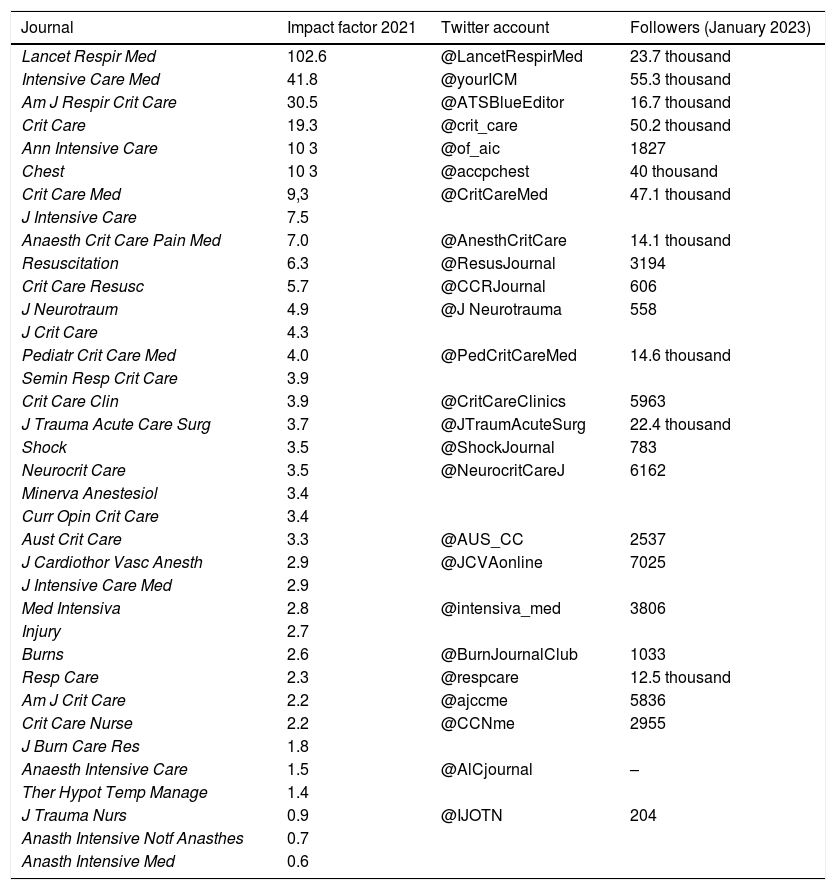The divulgation of scientific research is essential. Peer review by medical journals has become the gold standard in recent decades for ensuring the quality and adequacy of the articles that are published. This process involves the independent and critical evaluation of an article by expert peers.1
In this context, the impact factor (IF) has been a measure of the importance of a scientific journal, based on the citations received by the articles it publishes. The IF is a tool used to compare journals and assess the relative importance of a given journal with respect to others within the same scientific field. Specifically, the IF of a journal measures the mean number of times the articles published in it have been cited in the course of a given year.2
However, entry into different social networks (SNs) has been made as part of the strategic objectives of many scientific publications. The reason behind this is fundamented on a novel reality: the new role of scientific interactivity in the biomedical field, the influence of the visibility of a journal on the web in order to increase its IF, and the advantages afforded for promoting the internationalization of the publication.3
However, scientific rigor - as measured by the IF of a journal - and repercussion in the SNs (taking Twitter® as an example), do not seem to match very well (Table 1).
The main journals in Intensive Care Medicine, ordered by impact factor in 2021, Twitter® account, and number of followers updated on 5 January 2023.
| Journal | Impact factor 2021 | Twitter account | Followers (January 2023) |
|---|---|---|---|
| Lancet Respir Med | 102.6 | @LancetRespirMed | 23.7 thousand |
| Intensive Care Med | 41.8 | @yourICM | 55.3 thousand |
| Am J Respir Crit Care | 30.5 | @ATSBlueEditor | 16.7 thousand |
| Crit Care | 19.3 | @crit_care | 50.2 thousand |
| Ann Intensive Care | 10 3 | @of_aic | 1827 |
| Chest | 10 3 | @accpchest | 40 thousand |
| Crit Care Med | 9,3 | @CritCareMed | 47.1 thousand |
| J Intensive Care | 7.5 | ||
| Anaesth Crit Care Pain Med | 7.0 | @AnesthCritCare | 14.1 thousand |
| Resuscitation | 6.3 | @ResusJournal | 3194 |
| Crit Care Resusc | 5.7 | @CCRJournal | 606 |
| J Neurotraum | 4.9 | @J Neurotrauma | 558 |
| J Crit Care | 4.3 | ||
| Pediatr Crit Care Med | 4.0 | @PedCritCareMed | 14.6 thousand |
| Semin Resp Crit Care | 3.9 | ||
| Crit Care Clin | 3.9 | @CritCareClinics | 5963 |
| J Trauma Acute Care Surg | 3.7 | @JTraumAcuteSurg | 22.4 thousand |
| Shock | 3.5 | @ShockJournal | 783 |
| Neurocrit Care | 3.5 | @NeurocritCareJ | 6162 |
| Minerva Anestesiol | 3.4 | ||
| Curr Opin Crit Care | 3.4 | ||
| Aust Crit Care | 3.3 | @AUS_CC | 2537 |
| J Cardiothor Vasc Anesth | 2.9 | @JCVAonline | 7025 |
| J Intensive Care Med | 2.9 | ||
| Med Intensiva | 2.8 | @intensiva_med | 3806 |
| Injury | 2.7 | ||
| Burns | 2.6 | @BurnJournalClub | 1033 |
| Resp Care | 2.3 | @respcare | 12.5 thousand |
| Am J Crit Care | 2.2 | @ajccme | 5836 |
| Crit Care Nurse | 2.2 | @CCNme | 2955 |
| J Burn Care Res | 1.8 | ||
| Anaesth Intensive Care | 1.5 | @AlCjournal | – |
| Ther Hypot Temp Manage | 1.4 | ||
| J Trauma Nurs | 0.9 | @IJOTN | 204 |
| Anasth Intensive Notf Anasthes | 0.7 | ||
| Anasth Intensive Med | 0.6 |
Obviating (perhaps needlessly so) payment for publication, do we seek rigor? Divulgation? The combination of both, if possible…?
In the case of researchers, a preference is observed for choosing scientific journals where the editorial product forms part of virtual communities. In other words, SNs represent an important window for divulgation among academics and diffusion between specialists and their audiences.4
But we must be careful when “clicking” on “re-send” and “likes”: the technique used by Goebbels as head of propaganda of the Nazi Party and later of the Third Reich can be summarized in a single phrase attributed to him: “A lie, if repeated a thousand times, becomes the truth…”.5
FundingThe present study has received no funding of any kind.
Conflict of interestThe authors state that they have no conflicts of interest in relation to this study.





